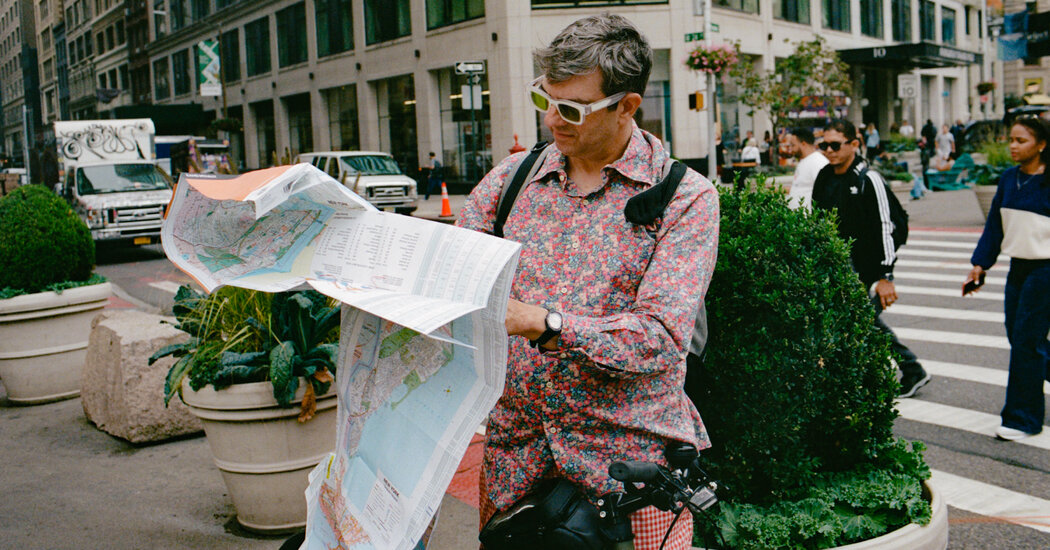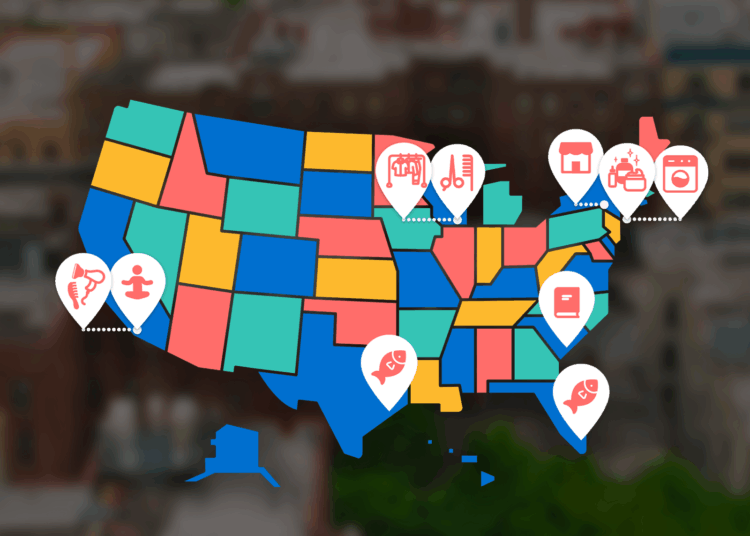When I decided to live without artificial intelligence for 48 hours, I figured it would affect some parts of my routine. I knew I wouldn’t be able to watch Netflix-recommended documentaries or read marketing emails written by bots, for instance. That I could deal with.
What I didn’t expect was that my attempt to avoid all interactions with A.I. and machine learning would affect nearly every part of my life — what I ate, what I wore, how I got around.
I undertook this experiment with the goal of seeing firsthand just how prevalent A.I. is in our everyday lives. Most people are aware that it peppers our social media feeds with targeted ads and powers the chatbots on airline reservation sites. I wanted to identify all the A.I. hiding in plain sight, and to find out what life would be like without it. I would spend two days as the No A.I. Guy.
“Good luck with that!” said Jeff Wilser, the host of the podcast “AI-Curious.” “I used to say that if you want to avoid A.I., you should go be a goat herder in the mountains. Now I can’t even say that, because goat herders probably use it, too, wittingly or not. For starters, they check the weather, and nowadays almost every weather prediction is made with A.I.”
While researching my subject, I encountered wildly conflicting opinions. Is A.I. overhyped, merely a glorified spell-check, as some people insisted in interviews with me? Or is it the biggest discovery since fire (actually bigger than fire, since it will replace humans), as others claimed?
Is it taking away our freedom of choice by forcing us to obey biased algorithms? Or is it making our lives better in a thousand small ways, as Garrett Winther, the chief product officer of the venture capital firm Newlab, argued.
“People think A.I. is scary,” Mr. Winther told me, “but, really, it’s improving our lives in ways we don’t even notice, allowing us to breathe easier. Literally.” He cited a recent New York State A.I. program that used the technology to monitor the air for abnormalities such as methane leaks.
Before I started my experiment on a random Monday in October, I had to answer a fundamental question: How should I define A.I.?
Many people associate the term with generative A.I., which burst onto the scene in 2022. It’s the technology that churns out college English papers and concocts images of smiling customers for soft drink ads. But the A.I. umbrella also covers other types of programs capable of learning and evolving — including machine learning, which has been widespread since the 2000s. A machine learning program updates itself or its predictions based on new data. When the Waze app finds a shortcut to your sister’s house, you can thank machine learning.
To be A.I.-free, I decided, I would avoid both Gen A.I. and machine learning. I would be a purist.
It Begins
From the moment I woke up in my New York apartment on Day 1, I realized that Mr. Wilser was correct to warn me about A.I.’s omnipresence.
Still in bed, I reflexively grabbed my iPhone so that I could hold it in front of my face and unlock the screen. But no. Facial recognition runs on A.I. I typed in my passcode like it was 2017.
What could I do with my phone now that it was open? Not much. No Facebook, no Instagram: Social media feeds are determined by A.I. and littered with A.I.-generated ads. How about a podcast? Nope. Many podcasts use A.I. editing programs to remove the “ums” and awkward silences.
Should I check the news? According to a 2024 Associated Press survey, 70 percent of journalists reported that their organizations used generative A.I. tools for research or other purposes. I would be cut off from current events — which could be a nice bonus.
Checking my email was also a no-no. Gmail uses machine learning to weed out spam. I put my iPhone in a drawer.
In the kitchen, my wife, Julie, flicked on the lights. I flicked them off.
“Are you kidding me?” she asked, patiently.
“The energy grid uses machine learning to predict where the demand will be,” I explained.
I spared her the details — that Con Edison feeds data from more than four million electric meters into a proprietary A.I. program to assess voltage and prevent equipment failure, as a company spokesperson told me.
I told Julie there was no reason to worry, though: I had prepared for this eventuality by purchasing a portable solar-power generator. I plugged a lamp into it and lit up the kitchen with pride.
Brushing my teeth was more of a challenge — at least if I wanted to use water. The New York City reservoir system has a machine-learning tool that takes data from more than 1,600 sensors, which it combines with historic data. Scientists and engineers use those findings to help anticipate demand and make decisions about infrastructure repair.
But I was ready for my self-imposed drought. Like a doomsday prepper, I had been collecting rainwater in a bowl outside my window. I know — a bit ridiculous. But the absurdity helped me see the world with new eyes. I was spotting A.I. everywhere, as if I had an ultraviolet flashlight revealing all the germs we can’t see.
The fact is, almost every object in our lives is affected by generative A.I. and machine learning — whether in its design, manufacturing, marketing or shipping. The question is no longer whether these new technologies touch something, but to what degree.
I decided to rate everything in my life on a scale of 1 to 10. If something owes its existence almost entirely to A.I. or machine learning, like the spam emails that clog my inbox, it gets a 10.
What about the tree outside my window? The New York Department of Parks and Recreation uses cars equipped with visual scanners to conduct an A.I.-powered tree census, which tracks the health of the city’s more than 600,000 sidewalk trees. So my neighborhood maple has been touched by A.I., but only tangentially. It scores a mere 1 out of 10. I can rest in its shade with just a little guilt.
Bartering for Food
My business meetings are often conducted over Zoom, which uses A.I. for noise suppression, among other things. So I was glad to have received an invitation to meet three other nonfiction authors at a restaurant downtown.
What to wear? Certainly not my H&M chinos, which scored a 4 on my ranking. Like many big clothing retailers, H&M uses machine learning to optimize shipping routes, and its designers have experimented with A.I.-powered tools.
To be safe, I dug out an outfit from the pre-A.I. era: A bright floral shirt and a pair of checkered pants I had inherited from my grandfather, who had an Austin Powers phase back in the 1970s. It wasn’t my usual nondescript outfit, and it made me nervous.
“It’s actually the coolest outfit you’ve worn since we’ve been married,” Julie said.
I usually check the weather on my phone before I leave the apartment. But weather apps use machine-learning data. So I resorted to an old-style app — sticking my hand out the window. About 75 degrees, no need for a jacket, though I did take an umbrella, since I didn’t know if it would rain.
“If you’re leaving, could you take out the garbage?” Julie asked.
Sadly, I could not. To be safe, I had to avoid contact with the New York City sanitation system, which uses A.I. robots to sort trash and relies on machine learning to optimize the garbage truck routes.
How would I get to the restaurant? Uber and Lyft were verboten, since they use A.I. for pricing, demand and scheduling. What about hailing a taxi? Still no. Automakers use A.I. to design parts, and more than half of modern cars come loaded with machine-learning features, such as the sensors that alert you when you have drifted into another lane.
I considered the subway. The Metropolitan Transportation Authority uses A.I.-enabled software to monitor fare-evasion patterns. And the electronic signs above the platforms — the ones that tell you it’s five minutes till the next train — are coded with the help of generative A.I. So the subway received a 2 on my scale.
Not bad. But a safer option might be a bicycle — not a Citi Bike, which uses machine learning to predict demand and determine the placement of bicycles. Instead, I borrowed my son’s bike from our building’s basement.
Alas, I was likely to incur a number of violations on my ride. The New York City Department of Transportation uses machine learning to analyze traffic and pedestrian flow.
I pedaled downtown nonetheless, pausing on a corner to examine a folding Rand McNally city map. Yes, you can still buy paper maps! Which was a good thing, since I couldn’t check Waze or Google Maps, which use machine learning to pinpoint your location and update your route.
I unfolded the map, battling gusts of wind while trying to figure out which avenues had bike lanes. I reflexively used my thumb and forefinger to enlarge Sixth Avenue. Well, almost. I caught myself at the last moment. Regardless, the map didn’t have that info. Utterly failing to refold it properly, I ended up stuffing the bulky paper accordion back in my bag.
Finally, I arrived at my destination, the Hole in the Wall restaurant in the Flatiron district.
“Thanks for organizing lunch,” I whispered to the author Jonathan Goodman, who had invited me.
“Why are you whispering?” he asked.
I explained that I was trying to avoid interacting with A.I. — and noted the presence of a man nearby who was wearing AirPods. The new Apple AirPods Pro3 include an A.I. feature that translates languages in real time. Hence my impression of John Krasinski in “A Quiet Place.”
Over lunch, we talked about the use of A.I. in publishing, including its impressive editing abilities. I gave up whispering and hoped for the best.
How to pay for my food? That was a headscratcher. Credit card companies use A.I. to detect fraudulent activity, as does the A.T.M. where I get my cash.
“Do you accept gold?” I asked the manager.
“I’m sorry, no,” he said. “I don’t know the rates of gold.”
That was a shame, because I had brought some with me. My mother, a jewelry maker, had given me three tiny 20-karat golden horses left over from a necklace she had made.
“Wouldn’t the world be a better place if everyone paid for stuff with tiny golden horses?” said the author Bree Groff, one of my lunch mates.
I figured cash was lower on the A.I. scale than credit cards, so I paid with $20 bills.
“Let’s get a selfie before we leave,” Mr. Goodman said.
“I don’t think I should,” I said.
Smartphone cameras use A.I. to figure out where to focus and how to adjust for lighting. But I had come prepared, with a vintage Kodak folding camera in my bag. I held it aloft.
“Everybody stay still for 20 minutes,” Mr. Goodman joked.
I snapped a photo. Or tried to. The shutter was stuck.
Truth be told, the restaurant meal had earned me several violations. The food service industry has A.I. aplenty. Some industrial farms use it to predict water and fertilizer needs. And my lunch ingredients had been trucked and shipped along A.I.-optimized routes. (I’d ordered scrambled eggs, figuring a one-ingredient meal required less A.I.)
There was also the fact that my lunch mates had reserved our table with the machine-learning-equipped Resy app. Further, the Parched Hospitality Group, which operates Hole in the Wall, uses A.I.-enhanced software for invoicing, payroll and food orders, according to Tom Rowse, the company’s chief strategy officer.
To atone for my restaurant sins, I decided to forage for my next meal in Central Park. I’d watched a video by Steve Brill, a forager known as Wildman who has gathered foodstuffs in New York City parks since the 1980s. I plucked up several plantain weeds (not to be confused with the much more delicious banana relatives called plantains).
At dinner, I tried them. They tasted like the dirt they had come from. I erased the flavor with some red peppers a friend had gotten at an organic farm.
That night, I collapsed into bed. Luckily, my mattress was not one of those “smart mattresses” that adjust the firmness and temperature with A.I.
Leaving the Algorithm
Not long after waking up on Day 2, I decided it was movie time.
A big downside of A.I. is that it can force us into cultural silos. Streaming services nudge us toward the types of entertainment we’re already familiar with. You liked “Notting Hill”? Here are two more Julia Roberts rom-coms!
I replaced the Netflix recommendation algorithm with my high school English teacher, a film buff. Before my experiment, I had emailed him for a suggestion. He responded: “Currently re-exploring Robert Altman — ‘Brewster McCloud’ … whoa.”
I had ordered this 1970 movie on DVD, and now I watched it on a portable DVD player we had neglected for two decades. “Brewster McCloud” was bizarre and whoa-worthy, and I was glad to be out of my Netflix bubble.
My next errand was walking our dog. Before leaving the apartment, I put on my anti-facial recognition sunglasses.
As Elizabeth Daniel Vasquez, a privacy advocate, wrote in The New York Times last month, the streets of Manhattan are monitored by thousands of security cameras, some operated by the New York Police Department, others by private businesses. After a suspected crime, the N.Y.P.D. can search the footage using A.I.-powered facial recognition software.
There is also the small — for now — threat of homemade facial-recognition systems. Last year, two Harvard students hacked Ray-Ban Meta glasses to include software that identified passers-by. So just by strolling on the Upper West Side, I risked interacting with A.I.
Hence, my Ghost sunglasses. I had bought them from Reflectacles, a privacy-protection company. The white frames and yellow-tinted lenses defy facial recognition cameras by blocking the infrared light they use to map our features. I relished the feeling of slipping under the radar.
“Hey, Elton!” one of my neighbors greeted me.
Back home, I had to make a phone call — a tricky undertaking, since the iPhone uses machine learning for noise suppression and energy efficiency.
Julie retrieved a landline telephone, curly cord and all, from a storage locker in the basement. It wasn’t a perfect solution — Verizon uses A.I. to predict damage to its fiber lines — but it ranked lower on my A.I. scale than a smartphone.
My plan was to attempt a herculean feat: To find an actual human being at eBay customer support who would talk to me about a lost order. I had paid for a vintage 1990s bike, which failed to arrive. That’s why I had settled for riding my son’s 2022 bike on Day 1.
First, I needed the number for eBay headquarters. I called 4-1-1.
“City and state, please,” said a robotic voice.
“Can I talk to a human being please?” I replied. Voice-recognition programs rated an 8 on my scale — they run on A.I. programs trained on millions of spoken words.
Moments later, a different voice said: “City and state, please.”
“Are you a human being?” I asked.
“Yes, I am.”
“Me, too!”
Silence. I requested the number for eBay. While the operator was looking it up, I asked, “By the way, what kind of people still call 4-1-1?” Silence. Then a robotic voice gave me eBay’s number.
Things went downhill from there. The eBay phone tree flat-out refused to connect me to a non-robot.
I spent the final hours of my experiment trying to draft this article. I couldn’t use my MacBook Pro, since it’s loaded with machine learning features, including a trackpad trained to ignore accidental brushes with my palm.
I got down to work on a typewriter I had bought days earlier. I loved the clackety-clack sound, but the ribbon was low on ink.
I switched to pencil and paper, despite my worry that the manufacturers of those simple writing tools were among the 51 percent of companies that use A.I. in hiring, according to a survey by Résumé Builders. Since my solar-power box had run out of juice, I wrote by candlelight. It was kind of soothing.
I checked the notes I had printed out before the start of my experiment. And here’s where I should make a confession: Some of my research came from ChatGPT. I’m part of a majority of journalists whose work has been changed by A.I. I gave it prompts such as “How does the Parks Department use A.I.?”, which led me to the tree census, for one thing.
So how am I feeling in these last few hours? A little unsettled by just how prevalent A.I. is. I’d like more transparency. It seems important to know when an image or email is A.I.-generated. And I’d like more control over the algorithms that influence my life.
I’m also less sure about how the world will look in five years, but more certain that A.I. will be increasingly involved. “We’re just at the beginning of the A.I. Era,” said Mr. Wilser, the “AI-Curious” host. On the spectrum of A.I.-is-glorified-spell-check to A.I.-is-bigger-than-fire, the project has moved me slightly in the bigger-than-fire direction.
If I were to write a sequel to this story in five years, I would have an even more difficult time. Or, as Jeff Crume, a scientist who makes popular A.I. explainer videos, put it: “You mean when ChatGPT writes a sequel to this article in five years?”
Good point.
Read by A.J. Jacobs
Audio produced by Sarah Diamond.
The post 48 Hours Without A.I. appeared first on New York Times.




